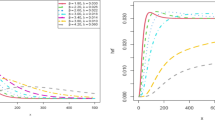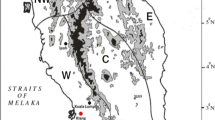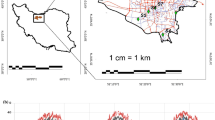Abstract
It is shown that distribution of PM2.5 concentration recorded by eight air quality monitoring stations during 2021, covering a large part of the Santiago metropolitan region of Chile, can be explained by a q-Weibull function, which has been related in some papers to complex and non-equilibrium statistical systems. It was found that this function has an excellent fit performance on non-filtered data, which cannot be reached by other physical-statistical functions widely used to modeling air pollution distribution in the literature. Finally, relevant interpretations from the fit parameters are shown as well.
Graphic Abstract







Similar content being viewed by others
Data availability statement
This manuscript has associated data in a data repository. [Authors’ comment: We cannot generalize the results based on what we observed during the year 2021 for the PM2.5 pollutant. It is important to note that on March 18, 2020, the “State of Constitutional Exception of Catastrophe, due to public calamity” began to apply in Chile, which was in force until March 13, 2021. It was later extended until September 2021 (Decrees 72 and 153 can be consulted on the official website of the Library of the National Congress of Chile https://www.bcn.cl), which brought a series of prevention measures, such as the closure of borders (air, land and sea), the declaration of a night curfew throughout the national territory, among other measures that affected environmental behavior in our study area (Santiago de Chile).]
References
V. Leiva, M. Barros, G.A. Paula, A. Sanhueza, Generalized Birnbaum-Saunders distributions applied to air pollutant concentration. Environmetrics 19, 235–249 (2008)
F. Vilca, A. Sanhueza, V. Leiva, G. Christakos, An extended Birnbaum-Saunders model and its application in the study of environmental quality in Santiago. Chile. Stoch. Environ. Res. Risk Assess. 24, 771–782 (2010)
Z.W. Birnbaum, S.C. Saunders, A new family of life distributions. J. Appl. Probab. 6, 319–327 (1969)
Z.W. Birnbaum, S.C. Saunders, Estimation for a family of life distributions with applications to fatigue. J. Appl. Probab. 6, 328–347 (1969)
B. Morel, S. Yeh, L. Cifuentes, Statistical distributions for air pollution applied to the study of the particulate problem in Santiago. Atmos. Environ. 33(16), 2575–2585 (1999)
P.G. Georgopoulos, J.H. Seinfeld, Statistical distributions of air pollutant concentrations. Environ. Sci. Technol. 16(7), 401A-416A (1982)
H.C. Lu, The statistical characters of PM10 concentration in Taiwan area. Atmos. Environ. 36(3), 491–502 (2002)
S. Nadarajaha, S. Kotz, On the q-type distributions. Physica A 377, 465–468 (2007)
G. Williams, B. Schäfer, C. Beck, Super statistical approach to air pollution statistics. Phys. Rev. Res. 2, 013019 (2020)
H. He, B. Schäfer, C. Beck, Spatial heterogeneity of air pollution statistics in Europe. Sci. Rep. 12, 12215 (2022)
C. Tsallis, Nonadditive entropy and nonextensive statistical mechanics—an overview after 20 years. Braz. J. Phys. 39, 337–356 (2009)
S. Picoli Jr., R.S. Mendes, L.C. Malacarne, q-Exponential, Weibull, and q-Weibull distributions: an empirical analysis. Physica A 324, 678–688 (2003)
S. Picoli Jr., R.S. Mendes, L.C. Malacarne, R.P.B. Santos, q-distributions in complex systems: a brief review. Braz. J. Phys. 39, 468–474 (2009)
P. Rosin, E. Rammler, The laws governing the fineness of powdered coal. J. Inst. Fuel 7, 29 (1933)
Z. Fang, B.R. Patterson, M.E. Turner, Modeling particle size distributions by the Weibull distribution function. Mater. Charact. 31(3), 177–182 (1993)
M. Jonasz, G.R. Fournier, The particle size distribution, in Light Scattering by Particles in Water. ed. by M. Jonasz, G.R. Fournier (Academic Press, New York, 2007), pp.267–445
W.K. Brown, K.H. Wohletz, Derivation of the Weibull distribution based on physical principles and its connection to the Rosin-Rammler and lognormal distributions. J. Appl. Phys. 78, 2758 (1995)
U.M.S. Costa, V.N. Freire, L.C. Malacarne, R.S. Mendes, S. Picoli Jr., E.A. de Vasconcelos, E.F. da Silva, An improved description of the dielectric breakdown in oxides based on a generalized Weibull distribution. Physica A 361, 209–215 (2006)
E. Koo, C.M. Tam, W.L. Chang, Statistical analysis of meteorological and SO2 data. In Proceedings, Annual Meeting, Air Pollution Control Association, vol. 5, p. 8 (1984)
J.A. Taylor, R.W. Simpson, A.J. Jakeman, A hybrid model for predicting the distribution of pollutants dispersed from line sources. Sci. Total Environ. 46(1–4), 191–213 (1985)
A.J. Taylor, R.W. Jakeman, Simpson, Modeling distributions of air pollutant concentrations—I. Identification of statistical models. Atmos. Environ. 20(9), 1781–1789 (1986)
R. Ganguly, B.M. Broderick, Performance evaluation and sensitivity analysis of the general finite line source model for CO concentrations adjacent to motorways: A note. Transport. Res. Part D 13, 198–205 (2008)
M.Y. Nasir, N.A. Ghazali, M.I.Z. Mokhtar, N. Suhaimi, Fitting statistical distributions functions on ozone concentration data at coastal areas. Malay. J. Anal. Sci. 20(3), 551–559 (2016)
S.D. Dubey, Compound gamma, beta and F distributions. Metrika 16, 27–31 (1970)
N.L. Johnson, S. Kotz, N. Balakrishnan, in Continuous Univariate Distributions, vol. 1. Wiley Series in Probability and Mathematical Statistics: Applied Probability and Statistics. Wiley, New York (1994)
A. Pelliccioni, I. Ventrone, U. Poll, L. Lepore, M. Angelon, Use of the Weibull distribution parameters to characterize the atmospheric pollution monitoring. Trans. Ecol. Environ. (1997). https://doi.org/10.2495/AIR970471
K. Briggs, C. Beck, Modelling train delays with q-exponential functions. Physica A 378, 498 (2007)
A.I. Aguirre-Salado, H. Vaquera-Huerta, C.A. Aguirre-Salado, S. Reyes-Mora, A.D. Olvera-Cervantes, G.A. Lancho-Romero, C. Soubervielle-Montalvo, Developing a hierarchical model for the spatial analysis of PM10 pollution extremes in the Mexico City metropolitan area. Int. J. Environ. Res. Public Health 14(7), 734 (2017)
Author information
Authors and Affiliations
Corresponding author
Rights and permissions
Springer Nature or its licensor (e.g. a society or other partner) holds exclusive rights to this article under a publishing agreement with the author(s) or other rightsholder(s); author self-archiving of the accepted manuscript version of this article is solely governed by the terms of such publishing agreement and applicable law.
About this article
Cite this article
Sánchez, E. Q-Weibull distribution to explain the PM2.5 air pollution concentration in Santiago de Chile. Eur. Phys. J. B 96, 108 (2023). https://doi.org/10.1140/epjb/s10051-023-00576-1
Received:
Accepted:
Published:
DOI: https://doi.org/10.1140/epjb/s10051-023-00576-1




